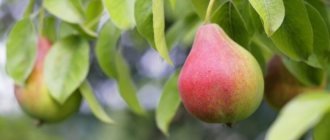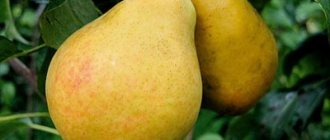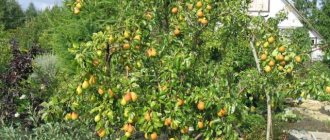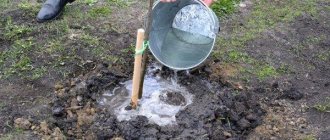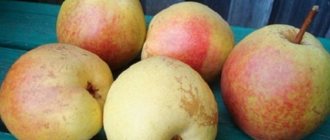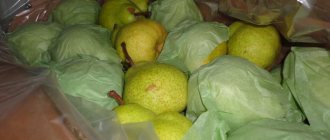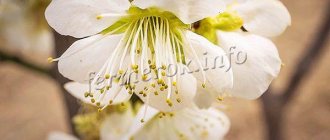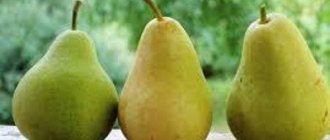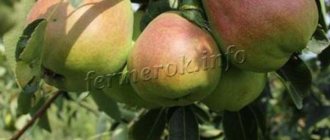Description of the Quiet Don pear
The Quiet Don pear is a hybrid from hybridization between the Rossoshanskaya Krasivaya and Mramornaya varieties. The variety was bred on the basis of the Rossoshansky zonal horticulture station by breeder A. M. Ulyanishcheva. The variety is included in the State Register in the Central Black Earth region.
The plant is characterized by moderate growth, in 10 years it grows up to 3 m. The crown is medium dense, slightly weeping. It has a round shape. The trunk is covered with gray bark, and the skeletal branches are gray-brown. They are placed in an inclined-vertical position. The type of fruit formation is ringed. The ringlets are located on 2-3 year old wood, sessile.
The stems are straightened, placed vertically, oblong. They are thickened and have a rounded cross-section. Their color is brownish-red. The internodes are medium located, the number of shoots is low, without pubescence. Lentils are small, medium thick. The buds are brownish in color and protruding. The foliage of the Quiet Don pear is rich green, shiny, has an average size, and has an ovoid shape. There is finely serrated serration along the edges of the leaves. The leaf blade is curved upward, leathery, and lacks pubescence. The length and thickness of the leaf petiole is average.
The inflorescence is made in the form of an umbrella-shaped brush. Each inflorescence contains approximately 8 flowers. The flowers and buds are deep white in color and cup-shaped. The petals are entire, tightly closed together. The pistil column is not pubescent, the stigma is located equally with the anthers.
Main advantages
As the pear grows, the fruits do not become smaller or fall off.
Quiet Don is chosen by more and more gardeners for the many advantages of the variety:
- rich pear taste and aroma;
- large ruddy fruits;
- early ripening (2 years compared to other pear trees, in which fruiting begins on average after 5–6 years);
- produces a harvest every year;
- high yield (by 10 years up to 70 kg);
- compact size of the tree, which is suitable for small areas;
- the fruits do not fall off or become smaller;
- large fruit;
- excellent taste and product quality;
- excellent resistance to scab;
- frost resistance;
- versatility;
- standard care (watering and fertilizing in spring).
The pear takes root well in many regions. The ideal place for breeding is considered to be the Central Chernozem, but with proper planting and appropriate care, the tree will bear fruit from year to year in the northern regions.
Flaws
The two main disadvantages of the variety are the lack of self-pollination and susceptibility to certain diseases.
Pears should be protected from the following diseases:
- sooty fungus copper dew forms on the leaves - a dirty black coating that can also be present on flowers and fruits; when the first symptoms appear, the tree is treated with organophosphorus solutions, and infective fruits are eliminated);
- septoria, or white spot (characterized by the appearance of pale grayish spots on the leaves; they may have a rusty edge; plants often become diseased in May; when the first signs of the disease appear, the trees are treated with a solution of nitrafen );
- fruit rot (a sign of the disease is the appearance of brown spots on the fruit, which can develop into growths, causing the fruit to become inedible; the fruit should be removed).
Fruit characteristics
On the Quiet Don pear, fruits of impressive size ripen, the weight of which reaches 270 g. The maximum weight of ripened pears is 350 g. The fruits have a blunt cone-shaped or oval shape. The peel is compacted. Upon reaching the stage of consumer ripeness, the color of the pears becomes yellowish-green, on which there is a pale blush of crimson-red color. The pears are densely covered with rich green subcutaneous spots. The stalk is compact and of medium size. There is usually no funnel, however, most often there is a slight influx near the stalk. The cup is half open or closed. The saucer is folded, small, its width is average. The subcalyx tube of the Quiet Don pear is small. The seeds are oblong in shape and brown in color.
The pulp of the ripe fruit is creamy-whitish, tender, oily, and oozes strongly. The taste is excellent, assessed by tasters at 4.8 points. Reviews of the Quiet Don pear confirm the assessment of its taste. It has a slight tartness and acidity. The commercial quality of the fruit is at a high level.
Photos and descriptions confirm the positive qualities of the Quiet Don pear variety.
Pros and cons of the Quiet Don pear variety
The benefits of Quiet Don pear include:
- precociousness;
- large fruit;
- immunity to scab;
- compact size of the tree;
- high taste and commercial quality of fruits.
Comment! Among the negative aspects of the Quiet Don pear variety, it is worth highlighting its susceptibility to pear worm and lack of resistance to septoria blight.
Harvest dates and rules
The timing of the pear harvest of the “Quiet Don” variety, popular among gardeners, depends, among other things, on the cultivation zone and weather conditions throughout the growing season.
The "Quiet Don" pear is an autumn variety whose ripeness occurs around the beginning or mid-September. The period of so-called consumer maturity is observed from the last ten days of September until November. At the picking stage, the skin of the fruit is characterized by a greenish-yellow color. In the phase of full ripeness, pears acquire a yellowish color with a blurred blush that has a beautiful orange tint.
It is recommended to harvest around mid-September, when the skin of the fruit is just beginning to turn yellow. In a cool basement, pears are able to maintain their visual appeal and excellent taste for a month and a half.
Optimal growing conditions
The Quiet Don pear variety takes root well in many regions. It is best to cultivate this hybrid in the Central Black Earth region, however, if cultivation techniques are followed, it can successfully grow in other areas, including those located in more northern latitudes.
The hybrid is characterized by a high degree of resistance to adverse environmental factors. Even in winters with temperatures down to -35C and below, the crust freezes by no more than 1.0 points. Due to spring frosts, which are observed during the flowering period, mass death of buds and flowers is possible. However, this also happened with most other varieties. The Quiet Don pear is drought-resistant. During a period of prolonged drought, fruit shredding or mass dropping is not observed.
Landing Features
The Quiet Don pear, like other varieties, can be planted in spring or autumn. The soil for planting should be as loose as possible, which will ensure good air circulation and access to the root system of the plant.
Soil preparation in the area intended for planting pear plantations, as well as high-quality organization of the territory, should be carried out by analogy with planting an apple orchard. Pear seedlings should be planted in pre-prepared planting holes, the diameter of which is 0.9-1 m with a depth of 0.6 m, well-filled with nutritious soil.
Spring planting is recommended at the end of April or early May, before the plant awakens. In autumn, it is advisable to plant pears in the first ten days of October.
In central Russia, early spring planting is recommended. The optimal distance between pear or apple seedlings should always be about 5 m. Step-by-step instructions for planting pear seedlings are as follows:
- dig a planting hole with steep walls corresponding to the size of the root system of the seedlings prepared for planting;
- pour a mixture of humus, turf, top soil and complex fertilizers into the planting hole;
- make a mound of soil in the center of the planting hole and drive a reliable support peg into it;
- place the root system of a fruit seedling on an earthen mound and carefully spread all the roots in the form of a fan;
- Cover the roots with fertile soil and lightly compact and compact the soil over the root system.
The root collar of the seedlings should rise above the ground level by about 3-4 cm. All planted plants should be fixed on support pegs, and then watered generously at the rate of a couple of buckets of water per pear seedling.
Mulching the soil in tree trunk circles has a very positive effect on the growth and development of planted fruit plants. It is recommended to keep the row spacing under black fallow in the first year after planting the pear. It is advisable to make a small hole around the trunk for watering the plants.
Planting and caring for the Quiet Don pear
To grow the Quiet Don pear variety, you need to plant the plants correctly. Subsequently, they need to be provided with quality care.
Landing rules
In order to properly plant a Quiet Don pear seedling, you must act in accordance with the following algorithm:
- Before purchasing a seedling, it is important to thoroughly examine it externally. Preference should be given to those specimens that have a branched trunk. The optimal age of the seedling is 3 years. It is best to plant the Quiet Don pear in the autumn, although planting can be postponed to spring.
- The place for cultivating the hybrid pear variety Quiet Don should be spacious and accessible to the rays of the sun. If possible, it should not be located in an elevated place. Pear has a positive attitude towards moisture, which accumulates during the winter in slightly low-lying areas.
- The site begins to be prepared at the end of August. The soil is dug up and superphosphates, potassium salts, and compost are added to it. Optionally, humus can be added.
- For a seedling, dig a planting hole slightly larger than the root system. A wooden stake is driven into the center of the pit, which should rise approximately 70-80 cm above ground level.
- Then the seedling is placed in the hole so that the root collar is 6 cm above the ground.
- After this, the roots are straightened so that they do not touch each other if possible, and covered with soil.
- After this, the seedling is tied to a peg using twine, which is twisted in a figure eight.
- If several seedlings are planted at once, the distance between them is 7 m.
- A small ditch is dug in a circle around the planted seedling, which is needed for watering.
- Immediately after this, the Quiet Don pear is poured generously with warm, settled water.
- Several watering cans of water are poured under the plant, one after another, waiting for the soil to settle. If necessary, you have to add soil.
- When watering is completed, the soil in the near-trunk sector is mulched. This is necessary to retain moisture and prevent weed growth.
Watering and fertilizing
Young seedlings of the Quiet Don pear require abundant irrigation, especially in 1 year of life. Water is brought into a small ditch that was dug when planting the plant. This will not only make the irrigation procedure easier, but will also prevent erosion of the roots.
Important! When irrigating, it is also possible to use an expander.
Autumn fertilization for the Quiet Don pear variety is carried out after the fruit harvest is completed, when a third of the leaves on the tree have already turned yellow. Young seedlings may not be fed for 2 years if fertilizers were applied during soil preparation. In autumn, fertilizing should not provoke secondary growth of shoots, so the use of nitrogen-containing elements is excluded. 2 tbsp. l. superphosphate and 1 tbsp. l. potassium chloride is diluted in a 10-liter container with water, mixed thoroughly and watered with the resulting solution over the plantings.
In the spring, several feedings are carried out. The first of them, which is aimed at activating the development of young shoots, is carried out using nitrate, urea, chicken manure and other nitrogen fertilizers.
When flowering begins, the pear is fed with nutrients that ensure high quality fruits. In this case, the best option is nitroammophoska. During the harvest, the Quiet Don variety is fed with phosphorus-potassium fertilizers.
Trimming
The formation of the crown of the Quiet Don pear begins after one and a half years from the moment the seedling is planted. The procedure is carried out in spring. The plant is pruned at a level of 0.5 m from the ground. This will ensure improved development of the crown and underlying branches. On 2-year-old seedlings, it is recommended to shorten interfering, vertically growing shoots.
Whitewash
The trunk of the Quiet Don pear needs to be whitened in order to facilitate the plant’s emergence from winter dormancy. You can either purchase whitewash in a store or do it yourself. In the latter case, it is necessary to dilute 1.5 kg of clay and 2 kg of lime in a bucket of water. Whitening the plant begins from the lower skeletal branches to ground level. Young seedlings can be completely whitened.
Preparing for winter
Before the start of winter, the soil in the tree trunk sector is dug up and spilled with water. After this, the soil is covered with humus with the addition of peat or sawdust. The layer thickness should be approximately 20 cm, which provides reliable protection for the root system of the Quiet Don pear.
For better wintering of the plant, it is recommended to cover it with snow. It has a positive effect on the condition of the root system. Snow provides roots with moisture and protects them from freezing.
Care
Watering
Newly planted seedlings require abundant watering. When planting, make a ditch around the plant. This will simplify watering and save you from washing away the roots. In the first year after planting, it is worth providing the crop with plenty of moisture.
Crown formation
Pruning must be done carefully. Quiet Don is pruned no earlier than a year after planting. You need to remove those shoots that are half a meter above the soil. In winter, young trees are usually covered with a small layer of snow.
Diseases and pests
The Quiet Don pear is relatively resistant to diseases, however, it can be affected by septoria. This disease manifests itself in the last decade of May. To prevent the disease, before buds begin to bloom, the plantings are treated with Nitrafen (300 g/10 l of water).
Plants can be damaged by rodents. The lower part of the barrel is wrapped in several layers of thick paper to prevent this.
Advice! It is permissible to use both appropriate insecticides and folk remedies against the pear borer and other harmful insects.
Reviews of the Quiet Don pear
Inna Vikhrenko, 37 years old, Novoshakhtinsk
The Quiet Don pear began to bear fruit in the 3rd year. The fruits are juicy and pleasant to the taste. There are no diseases, but I still spray it just in case. The tree bears fruit every year; I haven’t noticed any periodicity in it. The variety propagates well from cuttings, almost all of them take root. I recommend him to everyone I know.
Egor Vasiliev, 58 years old, Penza
The productivity of the Quiet Don variety is simply off the charts. This is the most productive pear variety in my garden. The fruits are delicious and the whole family likes them. I constantly treat it to my family and friends, everyone praises the taste of these pears. It survives the winter well, almost does not freeze. The tree just needs to be formed correctly.
Nelly Kravchuk, 34 years old, Kaluga region
I have been growing the Quiet Don pear on my plot for 8 years. The harvest is large, the fruits are huge, I collect them every year. Trees rarely get sick with anything, only sometimes I detect septoria. For the winter, it is better to cover the trees with peat and pile more snow on them, so they will freeze less.
Reviews from gardeners
Gardeners in our country have appreciated the positive characteristics of the autumn pear variety “Quiet Don”, and reviews of this variety are mostly positive. The plant is favorably characterized by high yields, resistance to scab, beautiful and large fruits that have a pleasant taste and can be stored for a fairly long time.
It should be noted that this variety is characterized by insufficient frost resistance. It is for this reason that in conditions of little snow and frosty winters, fruit plantings are often severely damaged.
Mother-in-law's tongue flower - home care
